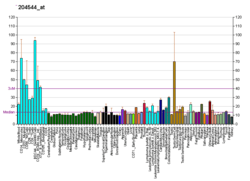HPS5
Hermansky–Pudlak syndrome 5 protein is a protein that in humans is encoded by the HPS5 gene.[5][6][7]
| HPS5 | |||||||||||||||||||||||||
|---|---|---|---|---|---|---|---|---|---|---|---|---|---|---|---|---|---|---|---|---|---|---|---|---|---|
| Identifiers | |||||||||||||||||||||||||
| Aliases | HPS5, AIBP63, BLOC2S2, biogenesis of lysosomal organelles complex 2 subunit 2, HPS5 biogenesis of lysosomal organelles complex 2 subunit 2 | ||||||||||||||||||||||||
| External IDs | OMIM: 607521 MGI: 2180307 HomoloGene: 35333 GeneCards: HPS5 | ||||||||||||||||||||||||
| |||||||||||||||||||||||||
| |||||||||||||||||||||||||
| |||||||||||||||||||||||||
| |||||||||||||||||||||||||
| Orthologs | |||||||||||||||||||||||||
| Species | Human | Mouse | |||||||||||||||||||||||
| Entrez | |||||||||||||||||||||||||
| Ensembl | |||||||||||||||||||||||||
| UniProt | |||||||||||||||||||||||||
| RefSeq (mRNA) | |||||||||||||||||||||||||
| RefSeq (protein) | |||||||||||||||||||||||||
| Location (UCSC) | Chr 11: 18.28 – 18.32 Mb | Chr 7: 46.76 – 46.8 Mb | |||||||||||||||||||||||
| PubMed search | [3] | [4] | |||||||||||||||||||||||
| Wikidata | |||||||||||||||||||||||||
| |||||||||||||||||||||||||
This gene encodes a protein that may play a role in organelle biogenesis associated with melanosomes, platelet dense granules, and lysosomes. This protein interacts with Hermansky–Pudlak syndrome 6 protein and may interact with the cytoplasmic domain of integrin, alpha-3. Mutations in this gene are associated with Hermansky–Pudlak syndrome type 5. Multiple transcript variants encoding two distinct isoforms have been identified for this gene.[7]
References
- ENSG00000288445 GRCh38: Ensembl release 89: ENSG00000110756, ENSG00000288445 - Ensembl, May 2017
- GRCm38: Ensembl release 89: ENSMUSG00000014418 - Ensembl, May 2017
- "Human PubMed Reference:". National Center for Biotechnology Information, U.S. National Library of Medicine.
- "Mouse PubMed Reference:". National Center for Biotechnology Information, U.S. National Library of Medicine.
- Nagase T, Ishikawa K, Suyama M, Kikuno R, Hirosawa M, Miyajima N, Tanaka A, Kotani H, Nomura N, Ohara O (Jul 1999). "Prediction of the coding sequences of unidentified human genes. XIII. The complete sequences of 100 new cDNA clones from brain which code for large proteins in vitro". DNA Res. 6 (1): 63–70. doi:10.1093/dnares/6.1.63. PMID 10231032.
- Wixler V, Laplantine E, Geerts D, Sonnenberg A, Petersohn D, Eckes B, Paulsson M, Aumailley M (Apr 1999). "Identification of novel interaction partners for the conserved membrane proximal region of alpha-integrin cytoplasmic domains". FEBS Lett. 445 (2–3): 351–5. doi:10.1016/S0014-5793(99)00151-9. PMID 10094488.
- "Entrez Gene: HPS5 Hermansky–Pudlak syndrome 5".
External links
Further reading
- Nakajima D, Okazaki N, Yamakawa H, et al. (2003). "Construction of expression-ready cDNA clones for KIAA genes: manual curation of 330 KIAA cDNA clones". DNA Res. 9 (3): 99–106. doi:10.1093/dnares/9.3.99. PMID 12168954.
- Strausberg RL, Feingold EA, Grouse LH, et al. (2003). "Generation and initial analysis of more than 15,000 full-length human and mouse cDNA sequences". Proc. Natl. Acad. Sci. U.S.A. 99 (26): 16899–903. doi:10.1073/pnas.242603899. PMC 139241. PMID 12477932.
- Zhang Q, Zhao B, Li W, et al. (2003). "Ru2 and Ru encode mouse orthologs of the genes mutated in human Hermansky–Pudlak syndrome types 5 and 6". Nat. Genet. 33 (2): 145–53. doi:10.1038/ng1087. PMID 12548288.
- Ota T, Suzuki Y, Nishikawa T, et al. (2004). "Complete sequencing and characterization of 21,243 full-length human cDNAs". Nat. Genet. 36 (1): 40–5. doi:10.1038/ng1285. PMID 14702039.
- Di Pietro SM, Falcón-Pérez JM, Dell'Angelica EC (2004). "Characterization of BLOC-2, a complex containing the Hermansky–Pudlak syndrome proteins HPS3, HPS5 and HPS6". Traffic. 5 (4): 276–83. doi:10.1111/j.1600-0854.2004.0171.x. PMID 15030569.
- Huizing M, Hess R, Dorward H, et al. (2005). "Cellular, molecular and clinical characterization of patients with Hermansky–Pudlak syndrome type 5". Traffic. 5 (9): 711–22. doi:10.1111/j.1600-0854.2004.00208.x. PMID 15296495.
- Gerhard DS, Wagner L, Feingold EA, et al. (2004). "The Status, Quality, and Expansion of the NIH Full-Length cDNA Project: The Mammalian Gene Collection (MGC)". Genome Res. 14 (10B): 2121–7. doi:10.1101/gr.2596504. PMC 528928. PMID 15489334.
- Helip-Wooley A, Westbroek W, Dorward HM, et al. (2007). "Improper trafficking of melanocyte-specific proteins in Hermansky–Pudlak syndrome type-5". J. Invest. Dermatol. 127 (6): 1471–8. doi:10.1038/sj.jid.5700737. PMID 17301833.
- Huizing M, Parkes JM, Helip-Wooley A, et al. (2007). "Platelet alpha granules in BLOC-2 and BLOC-3 subtypes of Hermansky–Pudlak syndrome" (PDF). Platelets. 18 (2): 150–7. doi:10.1080/13576500600936039. PMID 17365864.
This article is issued from Wikipedia. The text is licensed under Creative Commons - Attribution - Sharealike. Additional terms may apply for the media files.




